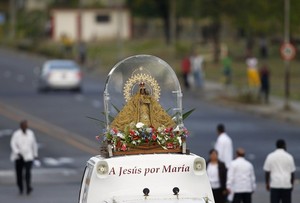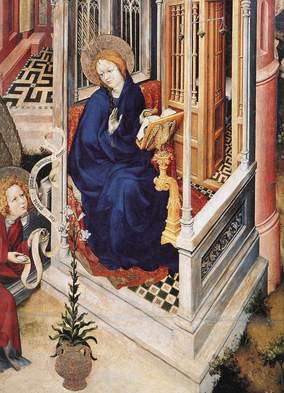 A rose among thorns. Well, almost. Man and woman
always want to give an expression of love and affection to another. In the
course of history you will notice the gifts of love's sentiment and reality
given to God, the Blessed Virgin Mary and the saints. Visit a shrine where
healings are reported and you'll notice tokens of gratitude: lockets, flowers, chalices, artwork, and the like. One beautiful gift of
love was given by Pope Benedict Monday evening to the Virgen de la Caridad de
Cobre in Cuba: a golden rose. The papal gift of a golden rose dates back to the
middle ages when a pope held a golden rose in a procession on Laetare Sunday,
the fourth Sunday of Lent. It was Pope Eugene III who called the rose a sign of
Christ's passion: the gold symbolizing the resurrection and the thorns the
suffering.
A rose among thorns. Well, almost. Man and woman
always want to give an expression of love and affection to another. In the
course of history you will notice the gifts of love's sentiment and reality
given to God, the Blessed Virgin Mary and the saints. Visit a shrine where
healings are reported and you'll notice tokens of gratitude: lockets, flowers, chalices, artwork, and the like. One beautiful gift of
love was given by Pope Benedict Monday evening to the Virgen de la Caridad de
Cobre in Cuba: a golden rose. The papal gift of a golden rose dates back to the
middle ages when a pope held a golden rose in a procession on Laetare Sunday,
the fourth Sunday of Lent. It was Pope Eugene III who called the rose a sign of
Christ's passion: the gold symbolizing the resurrection and the thorns the
suffering.Over time the golden rose was given to Church dignitaries thus
expanding the meaning: a personal honor and a reminder: do not forget the
responsibilities and duties that come with being a Christian. Beyond the human
honor given to royalty, the rose was given to abbeys and sanctuaries of the
Virgin Mary. Pope John Paul II gave a few these roses to shrines and Pope
Benedict XVI is fond of the custom and so he's given roses to Altötting, Mariazell,
Fatima, Aparecida, USA and now to Cuba.



